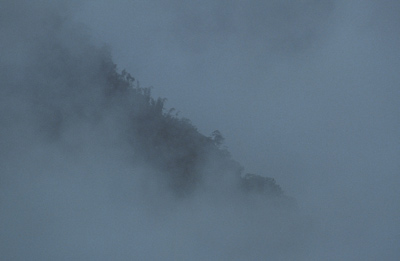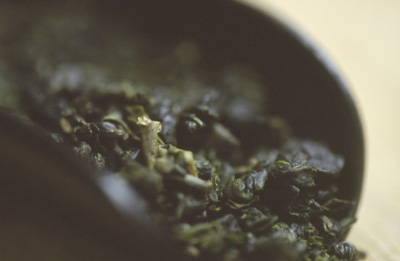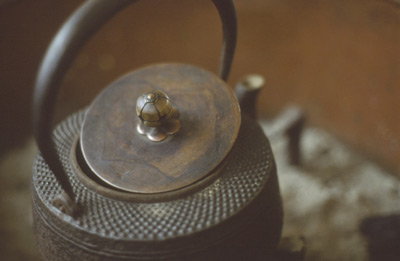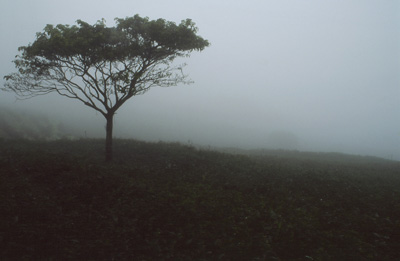An Oolong Quest in Taiwan
The mists cleared long enough for me to glimpse terraces of green black tea fields. Then just as quickly the mists enveloped everything. Landscape had long since disappeared, mists and fogs played peek-a-boo. My little car rumbled up further into the hills, further into the dark. At over 2000 meters all was gray and wet on this volcanic island of Taiwan.

This central part of Ihla Formosa (Taiwan) was home to that which I sought, the famed High Mountain Oolong tea. Two-thirds of Taiwan is mountain-covered. With fifty peaks over 3000 meters, this wet green island sitting off China’s coast provided the perfect home for the fabled tea. My destination was a teahouse run by a family that had grown specialty Oolongs for 200 years, after emigrating from the Wuyi region of Fujian province in China (the ‘birthplace’ of tea).
Grinding up yet another road I was suddenly there, the Chinese symbol for tea hanging in the fog, still and wet. Three buildings sat in a courtyard and through the haze my hosts emerged from a white square house. A shirtless man built of stone, Father, and a smiling woman; his daughter Wing welcomed me in Taiwanese (language of Fujian) and Chinese. Father (who at seventy looked forty) and Wing led me into a moss-covered hut. We sat down on worn wooden stools surrounded by tea, its scents and colors, and it seemed a casual shrine of sorts paying homage to a green leaf. I had long been a devotee of the tealeaf in all of its manifestations, and a mutual friend had suggested coming here to further my “study/devotion” to it. Tea history and culture is both art and science; its primary role in history has been associated with hospitality throughout Asia.
Wing and Father (and most likely the entire family), were what is known as cha shi (tea masters). The experience that was forthcoming, known as gong fu cha or ‘tea method’ brought tea and instruments together with the drinker. The tea used, an intoxicating Oolong, was renowned for its flavor because of the adherence to the original process.

Before me, on a slab of wood, which acted as the table, sat the three vitals of this ancient art: the tea itself rolled tightly in balls, spring water, and a clay teapot. Father’s eyes grew intense when explaining the water, “Fresh spring water is alive and is as essential as the tea quality.” He softened once again. “The semi-fermented or blue teas need boiling water, but not over boiled.” He gently poked at a kernel of Oolong. The Oolongs belonged to the blue-green (or Ching) family, fermenting anywhere from 10%-60%, and while names and vintages number in the thousands; it is perhaps the least known of teas.
Names of particular Oolongs like Hong Shuei (“red water”), and Dong Ding (“location”), might reflect the origin or a poetic description. The name Oolong itself can mean ‘jet dragon’, or ‘black serpent’ due perhaps to the shape as it unfurls.
Father grew intense again as water came into the subject spotlight. Water can be ‘killed’ if over boiled and the oxygen ‘burned off’—which judging from Father’s face, and Wing’s frown was punishable by a slow death. Water was brought to a gentle boil, and Wing’s deft hand poured it over the clay pot, into the cups, warmth infusing all of the parts. Next the water was poured into the pot that housed the precious little balls of tea so that it ran over the rim, “to expel the bitter froth which came to the surface.” Wing explained that the leaves were now ‘reawakening’. I peered into the minuscule pot looking for signs of life…and indeed leaves slowly unfurled, letting off aromatic vapors into the damp air. After 40 seconds it was emptied again into the three cups, which were subsequently drained. Now we were ready for the first infusion of this sacred fluid.
At this juncture, Father moved closer, intensifying and gesturing to the cha hu (teapot). A tea’s essence and character was extracted from the earth and the environs in which it lived and an Oolong’s particular character came out only in a perfect pot. The famed Yixing teapots of Dingshu, China, are made of clay and sandstone. Its porous qualities absorb the oils and properties of a particular tea. Thus one pot is used for one tea. Pots of many colors lined the wall to my left and awaited their commands.

Tea was then poured into another container, the open topped cha hai or pouring pot. With a flourish, Wing poured the contents into tall cylindrical cups. These ‘smelling’ cups only held the tea long enough to capture a little aroma. We jutted our noses in to capture the first genuine smells of this Gow Shan (High Mountain) Oolong. These were in turn poured into our tiny white drinking cups (or Cha Bei). The time had come to savor.
Our slurps allowed oxygen into the mouth, as with wine and scotch. Two healthy inhalations and we were ready for the second round. The smallness of the pot and cups allowed specific portions to be drunk without the temperature or consistency altering. For committed tea drinker’s consumption is an all day, everyday affair so the amounts are significantly less per serving. Drinking here with the tea plants so close in this little abode, one could appreciate coming to the ‘source’ seeing directly the unpretentiousness and vital nature of this custom.
Wing looked up from her kettle and pronounced that the second upcoming pot was the best. Repeating the process with Father speaking, my taste glands detected smoky and sweet simultaneously, while swallowing left sweetness trailing into my throat. I mentioned this and father let out an “Aaaahhhhh! That is exactly the beauty of Oolongs. Their finish.”

After successive pots and no perceptible change in strength, the second lesson was learned: True vintage teas can be used for multiple infusions without losing potency, needing only slightly longer to infuse each consecutive pot. One of the wonderful contradictions with tea is that the lighter (e.g. green tea) the color, the higher the stimulant or ‘caffeine’ effect, whereas the darker the color (e.g. black tea), the lower the ‘kick’.
Father decided that it was time to introduce the plant origins of this elixir. Finally grabbing a shirt he led me into the fog-lined hills where rows of green ascended the slopes. I noticed his face was set in a gentle smile. These were his children. Taiwan’s volcanic origins and misty altitudes provide perfect nourishment for Oolongs.
Walking along a damp path he recounted the days when he still aided in the picking himself, staying up for two or three days in the hills, only picking in the mornings after the moisture has evaporated from the leaves but before the humidity of midday. After three to five years, the tealeaves are ready to be picked, and while up to six harvests a year are possible in Taiwan, the spring and winter harvests are superior.
At this point his huge fingers softly pinched the last two leaves using only his nail. Lovingly he held up the bounty. One bud or heart per leaf. This is how the high quality Oolong is handpicked. With a brisk show of gestures Father told me of the urgency once the shoots are picked and how quickly they must be treated. Fermentation begins immediately, and then drying takes place, rolling and in some cases roasting depending on the tea and its master. “Drying under the sun,” he whispers, “is too quick and subtle tastes are lost, becoming coarser.” His grim face emphasized the point. “At ten years, a tea plant starts creating outstanding vintages.” At this point, an iron grip grabbed my wrist, and he whispered about tea plants that were ‘ancients’ way up. Nothing was visible through the fog but his eyes shone in the hills. “Old” was his answer to my forming question.

His voice dropped. “There is wild tea that grows on its own, special tea that people search for…it hides and has been here for hundreds of years.”
As we re-entered the sanctum, tea’s simple purpose was made clear. As a natural thirst quencher it is unrivalled. Polyphenols, proteins, vitamins a, b, and c, amino acids and more fluoride than any plant on earth along with hundreds of other compounds are found in tea, but for me at least this stunning array of benefits were temporarily forgotten.
Wing was happy to have us back, with a riot of family members having joined in. Father sat down and the eight of us sipped on a powerful Oolong, which was the ‘family favorite’. I asked where this was from Father’s eyes looked up to the invisible spot way up to the hill where the ‘ancients’ grew. Perhaps this was tea’s gift: that beyond talk of vintages, elegant names and histories, its basic function was still to bring people together. Ironic that what spends its life lonely in the mists and mountains alone is rarely consumed without friends.
Resources: Please consult the following websites for additional information:
Wang De Chuan Tea: www.dechuantea.com
Jeff Fuchs Photography: www.jefffuchs.com
